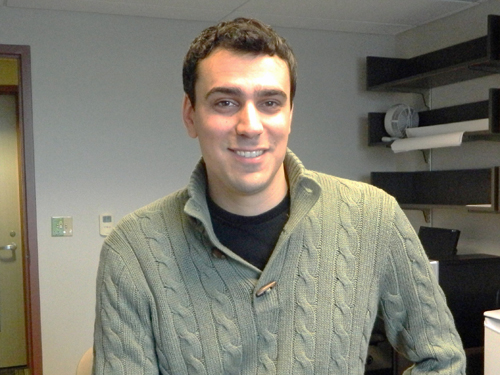
Imagine you’re driving your car in downtown Toronto. All around you are other cars, street signs, store windows with bright displays, street lights, pedestrians, cyclists and more. Inside the car, the moving dials and screens on your dashboard also vie for your attention.
With all that going on, how do you actually drive? Out of all this visual chaos, how does your brain sort out what elements are important to pay attention to, so that it can give you the information you need to drive safely?
That’s what psychology professor Naseem Al-Aidroos wants to understand. He’s researching what psychologists call “attentional mechanisms” – strategies the brain uses to focus attention where it’s needed and filter out the less important items.
“Some of these mechanisms are controlled consciously,” says Al-Aidroos, “such as when you are looking for a red sign and deliberately ignoring any green or blue signs.” Others, such as the flashing red and blue lights of a police car, seem to capture your attention whether or not you want to focus on them.
While in the past psychologists had to analyze people’s behaviour to estimate what was going on inside the brain, today technology gives a peak into the brain’s inner workings. Al-Aidroos and his colleagues use functional magnetic resonance imaging (MRI) to see exactly what’s happening.
Study participants undergo an MRI while viewing a series of composite images (in this study, the picture contained an image of a face superimposed on the image of a house or building). Some of the time participants were instructed to tell the researcher if any of the faces repeated (encouraging them to pay attention to the faces rather than the buildings) and at other times were asked to tell them if any of the buildings in the photos had been duplicated (so they would focus on the buildings).
The resulting MRI data was then analyzed. The part of the brain that processes visual information can be divided into several regions that each support different tasks, and these regions have been mapped out by previous researchers. What Al-Aidroos found was that when subjects were asked to pay attention to the faces they were seeing, there was increased communication between the part of the brain that is dedicated to identifying faces and the rest of the visual regions. When asked to watch for duplicated houses in the series, the part of the brain that is involved in recognizing buildings showed more communication with other visual regions of the brain.
Al-Aidroos explains: “This shows that attention can regulate communication so that visual information flows through goal-relevant regions of the brain.”
There’s more. Al-Aidroos found a connection between how much the communication increased and how good the study participants were at completing the tasks. Participants who were the best at detecting face repetitions on the face task, and building repetitions on the building task, also showed the greatest changes in communication from task to task. It seems that the flexibility of neural communication is an important predictor of an individual’s attentional abilities.
Al-Aidroos grew up in Waterloo, and earned his first undergrad degree at the University of Waterloo in computer science. He took a couple of psychology courses while there, and found them so intriguing that he opted to stay another year and complete a psychology degree as well. “I worked in a lab as a research assistant, and enjoyed it so much that I decided to go on to grad school,” he says.
He completed his PhD at the University of Toronto, and then headed to Princeton University for a post-doc before taking a position at U of G in January 2012.
Al-Aidroos hopes to extend his research to see how our ability to pay attention changes as we grow older. “It’s well known that attentional abilities change as we age,” he explains. “Part of my research program is to investigate these differences, the challenges they cause to daily life, and how these challenges can be overcome.”
His earlier study was done with people ages 20 to 32, so one goal is to repeat the study using a broader age range. “Because the ability to control communication was a strong predictor of attention in younger adults, changes to this neural ability may also explain the behavioural differences we typically see in older adults. Identifying such underlying mechanisms is an important step towards developing effective strategies to compensate for the negative consequences of these changes” he says.
Another planned research project is to see how visual images are moved into “working memory” – the part of the brain that holds an image so that it can be used in some way.
“Our brain is quite remarkable,” says Al-Aidroos. “Think of the person at airport security, reviewing the scanned images to look for a hidden gun or other dangerous items. Even sophisticated computers have difficulty with this task. But our brains do this kind of seeing and analyzing and comparing all the time, and we’re usually not even aware of it.”
And when Al-Aidroos looks around at his new environment, it looks good. He is enthusiastic about being part of the U of G community, and is pleased to be back in southern Ontario, where his family and his wife’s family live. After putting his hobbies on the back burner in recent years, he’s looking forward to doing some sailing on Guelph Lake this summer, and getting a new bicycle so he can start biking again.